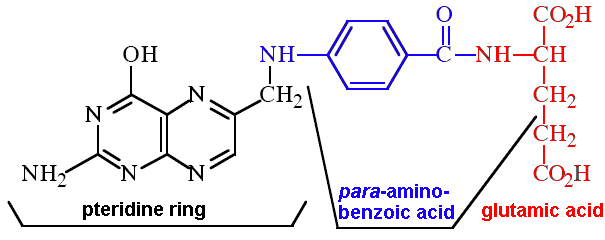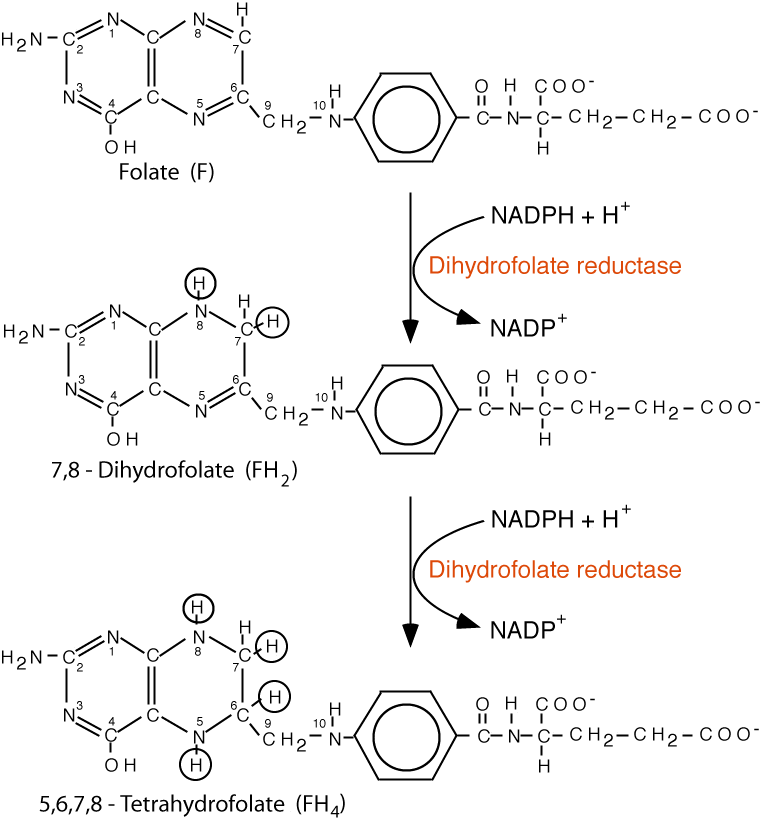Folate is the combination of a pterin ring, p-aminobenzoate and glutamate
( possibly multiple glutamate units ).

Folate

The initial product is folate, which has the second ring fully desaturated. This is reduced by dihydrofolate reductase by two moles of NADPH, first to dihydrofolate, and finally to tetrahydrofolate, THF.

folic acid dependent reactions


Methionine synthesis

Methionine

Methionine is necessary for synthesis of:



Creatine synthesis requires glycine, arginine, ATP
PROTEINS
more details

FIG. 3. Box plots demonstrating relative levels of metabolites. (A) methionine metabolism; (B) glutathione metabolism. © Box plots of serum taurine and glycine. (D) qRT-PCR of hepatic mRNA expression of genes related to methionine metabolism, trans-sulfuration, and DNA methylation pathway in controls (n = 10, in duplicate) and those with ALD (n = 30). *P < 0.05, **P < 0.01, ***P < 0.001, ****P < 0.0001. (E) Schematic diagram illustrating the methionine metabolism pathway. (F) Hepatic taurine and glycine concentration from controls (n = 12) and from those with ALD (n = 30). Abbreviations: AHCY, adenosylhomocysteinase; BHMT1, betainehomocysteine S-methyltransferase 1; CBS, cystathionine-beta-synthase; CDO1, cysteine dioxygenase type 1; CTH, cystathionine gamma-lyase; DNMT, DNA methyltransferase; GNMT, glycine N-methyltransferase; MTHFR, methylenetetrahydrofolate reductase; N5-MTHF, N5-methyltetrahydrofolate; PEMT, phosphatidylethanolamine methyltransferase; SAH, S-adenosylhomocysteine; SAM, S-adenosylmethionine; THF, tetrahydrofolate.
Serum Metabolomic Profiling Identifies Key Metabolic Signatures Associated With Pathogenesis of Alcoholic Liver Disease in Humans, 2019
Linus Pauling Center: Folate

http://images.slideplayer.it/1/568286/slides/slide_30.jpg

C1 metabolism short
Folate coenzymes
Folic acid nomenclature and symbols
MethylTHF is essential for all methylation reactions including Choline synthesis
BH4 synthesis from GTP

BH2 reduction to BH4
Open Questions
Folati connessi a performance cognitiva
Sussiste un'associazione fra elevate concentrazioni plasmatiche di folati ed una migliore performance cognitiva, a prescindere dalla concentrazione di omocisteina. Con l'incremento della concentrazione di folati si osserva una significativa diminuzione del volume delle lesioni della materia bianca (WML) e del numero di lesioni gravi. Dato che le WML preventricolari e subcorticali sono in genere considerate marcatori di patologie microvascolari cerebrali, e la perdita di volume ippocampale ed amigdalare indicatori precoci di morbo di Alzheimer, i dati del presente studio suggeriscono che lo status relativo ai folati sia correlato alla sfera cognitiva tramite meccanismi vascolari piuttosto che con un processo neurodegenerativo primario. (Am J Clin Nutr 2007; 86: 728-34)
Folates and thymidine synthesis
Folic Acid Supplementation
ISS - Istituto Superiore di Sanita'
Acido Folico per la Prevenzione Primaria di Difetti Congeniti
A Livello Nazionale ed Internazionale e' Ormai Riconosciuto il Ruolo dell'Acido
Folico nella Prevenzione di Alcuni Difetti Congeniti. Le Maggiori Organizzazioni
Scientifiche che si Occupano di Prevenzione e Protezione della Salute sono
Impegnate nella Valutazione Attenta del Rapporto Rischio-Beneficio e della
Efficacia delle Diverse Strategie Attuabili Utili a Coprire il Fabbisogno di Questa
Vitamina nella Popolazione Generale e Soprattutto nelle Donne in Eta' Fertile
Queste Valutazioni Rappresentano un Elemento Fondamentale ed
Irrinunciabile Affinche' le Istituzioni Possano Attuare Decisioni in Materia
Il Documento Contiene i Riassunti del Convegno del Network Italiano Acido
Folico che si Terra' a Roma il 09 Ottobre 2009
Folic Acid Supplementation and embryo selection

The balance between the use of methylene-H4 folate for DNA synthesis rather than for methionine synthesis might depend on the presence of the 677T variant of methylenetetrahydrofolate reductase (MTHFR) and the nutritional folate status. Given adequate dietary folate, the 677T variant of MTHFR functions as a 'valve', preferentially routing one-carbon units to DNA at the expense of methionine. If folate nutritional status is poor, the 677T variant might promote the misincorporation of uracil into DNA, leading to chromosome breakage. This mechanism might therefore select embryos that are best suited to reproductive success for a given environmental abundance of dietary folate by augmenting dTMP (deoxythymidine monophosphate) synthesis. Therefore, given the current practice of increasing dietary folate before conception, in utero selection of the 677T variant might lead to a negative, long-term effect on the prevalence of cancer and vascular disease for which this mutation is a potential risk factor.
from Folic acid — vitamin and panacea or genetic time bomb? 2005
BH4/folate interactions
Novel Therapeutics for Depression: L-methylfolate as a Trimonoamine Modulator and Antidepressant-Augmenting Agent 2007

fig. 5
Inhibitors
Inhibition of folate-dependent enzymes by non-steroidal anti-inflammatory drugs